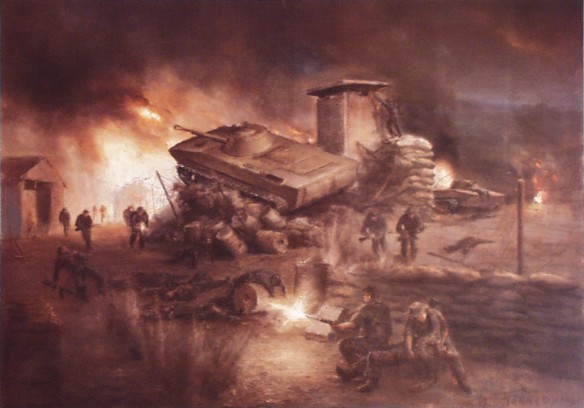As PAVN forces completed their encirclement of the Marines at Khe Sanh, they made preparations for a major assault on the nearby Special Forces camp at Lang Vei. Twenty-four members of the American Special Forces team and their Montagnard troops, as well as some Laotian soldiers who had fled their homes just across the border during a Communist attack some days earlier, manned the base. The total allied force numbered about four hundred troops.
The shelling of Lang Vei began in the early morning hours of February 7. Then, at first light, the PAVN struck in force spearheading their attack with eleven Soviet-made PT-76 amphibious light tanks, marking the first time that tanks had been used by the Communists in South Vietnam. Although the defenders received artillery support from Khe Sanh, Camp Carroll, and the Rockpile, they were soon overrun. Calling down artillery and air strikes on top of their own position, the commander of the camp, thirteen of his Green Berets, and some sixty Montagnards managed to break out to the east. Marine helicopters picked them up later that afternoon, but half the original garrison was unaccounted for, and ten of the twenty-four Americans at Lang Vei had been killed.
The appearance of tanks at Lang Vei rightfully concerned many of the Marines at Khe Sanh. With tanks, they reasoned, the PAVN could take Khe Sanh anytime it wanted. Still the Communists made no direct move on the combat base. However, they continued to apply pressure on the base while ground and artillery and mortar attacks continued against the Marine positions in the surrounding hills.
It appeared to the Marine defenders that the enemy was preparing for another major attack on Khe Sanh. Based on the previous enemy activity in the area, they thought that the PAVN would attack the Marine outposts to the north of the base and then make a direct attack on the main base from that direction. They also believed that another PAVN division would attack along the axis of Lang Vei–Khe Sanh village and then make its final assault on the base from the south and east.
While the Marine defenders waited for the next attack, they were unaware that the Communists had encountered serious problems elsewhere that would have an impact on the situation at Khe Sanh. As the fighting in Hue increased in intensity, Giap began to withdraw PAVN units from the Khe Sanh area to reinforce his beleaguered troops, who were trying desperately to hold on to the old imperial capital. Around February 10, five PAVN battalions began moving from the Khe Sanh area to join their comrades in Hue.11 Although the PAVN had thinned their forces in the area, they still had sufficient troops to keep Khe Sanh encircled and continuously bombard it with rockets, mortars, and artillery.
Such tactics had proved successful against the French at Dien Bien Phu in 1954. However, as noted, there were some crucial differences between the situation at Dien Bien Phu and the one at Khe Sanh in 1968, not the least of which was that Khe Sanh was never truly besieged in the classic sense of the term. Whereas the Viet Minh had been able to sever virtually all outside support from the French defenders at Dien Bien Phu, the Marines at Khe Sanh were never cut off, and U.S. forces never lost the ability to reinforce and resupply the base.
In addition, the Marines held the vital hill positions to the north and west of Khe Sanh and actively conducted patrols in the areas surrounding the combat base. Consequently, the PAVN appeared content for most of the seventy-seven days to hold their positions and bombard the defenders with 122mm rockets and 82mm and 120mm mortars from positions in an arc about two thousand to three thousand yards north and west of the base, while long-range 130mm and 152mm guns fired on the Marines from concealed positions on Co Roc Mountain across the border in Laos. The defenders received an average of 2,500 rounds a week in an area little more than 1,750 yards long and 875 yards wide.
In the United States, the U.S. media continued to report on the situation at Khe Sanh, implying that it was in imminent danger of being overrun by the Communists. On February 27, Walter Cronkite intoned that “Khe Sanh could well fall, with terrible loss in American lives, prestige, and morale.” No doubt influenced by such gloomy reports, some of Johnson’s advisers had begun to question the wisdom of continuing to hold Khe Sanh in the face of the continued siege, but Westmoreland remained convinced that the Marine base was critical and was steadfast in his insistence that Khe Sanh be held.
